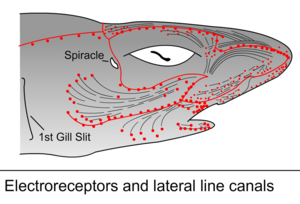Magnetosensorisch vermogen bij mensen
Magnetosensorisch vermogen bij de mens
- Gegevens
- Gepubliceerd: woensdag 14 maart 2012 09:14
| Is het fenomeen elektrogevoeligheid zo ver gezocht? Eigenlijk niet. Van vele diersoorten waaronder vogels en bijen is geweten dat ze over een goed functionerend en uiterst gevoelig 'elektroreceptief systeem' beschikken, waardoor ze het (zeer zwakke) magnetische veld van de aarde kunnen waarnemen om zich op basis hiervan te oriënteren. Dit elektroreceptief (of magnetosensorisch) vermogen berust op de aanwezigheid van 'magnetiet' in de weefsels; een sterk geleidend mineraal dat in zeer grote mate in staat is om elektromagnetische straling te absorberen en te geleiden. Het magnetiet zit geclusterd in magnetosomen. Als men dan weet dat ook de mens afstamt van een diersoort met een sterk ontwikkeld elektroreceptief systeem (cfr. studie van Modrell et al. gepubliceerd in Nature) en dat de menselijke hersenen royaal zijn voorzien van magnetiet (meer info), zoals aangetoond in het onderzoek van Kirschvink, is het dan zo verbazingwekkend dat mensen gevoelig kunnen zijn voor elektromagnetische velden? Op die manier bekeken zou men elektrohypersensitiviteit kunnen beschouwen als een evolutionair restverschijnsel. |
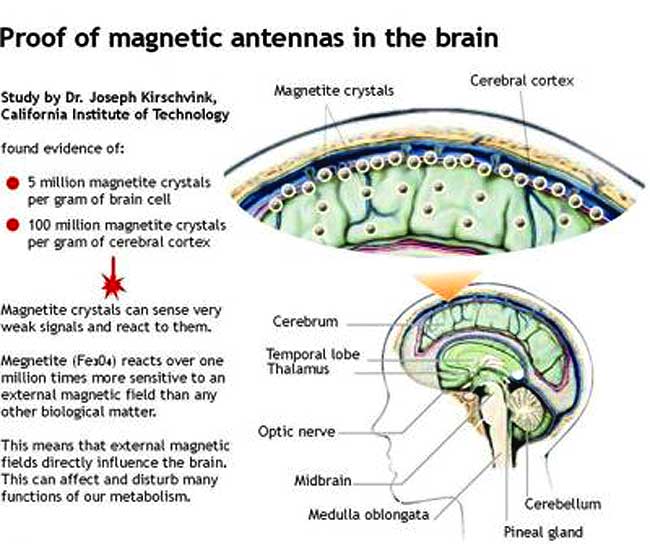
- 'Magnetiet in het menselijk lichaam' (PDF), door dr. Jean Pilette (zie p. 14 en 15 in het document Zendmasten, draadloze technologie en gezondheid)
- Experimenten van geofysicus Joe Kirschvink van het California Institute of Technology wijzen op het bestaan van een magnetisch 'zesde zintuig' bij de mens:
- Maverick scientist thinks he has discovered a magnetic sixth sense in humans, Science Magazine, 23/06/2016
- Scientist claims he's discovered a magnetic 'sixth sense' in humans, Science Alert, 27/06/2016
“It’s part of our evolutionary history. Magnetoreception may be the primal sense.”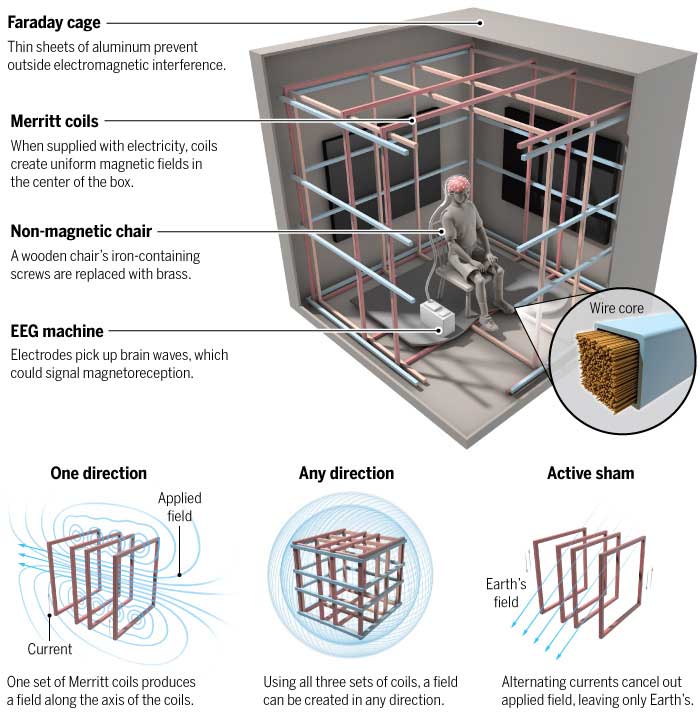
Experimentele set-up onderzoek Kirschvink

Van dieren was al eerder geweten dat ze over een soort van 'ingebouwd magnetisch kompas' beschikken
- "Cornell biologists may have made a breakthrough in understanding why some people are electrosensitive. They report in Nature Communications that humans as well as many other species descended from a type of fish that lived some 500 million years ago which had a "well developed electroreceptive system." A possible implication is that some of us, like sharks and rays, may be able to detect very weak electric fields and perhaps a subset has an electroreceptive system that has gone awry. We concede that this is speculation on our part; for a more direct interpretation of the new paper, read the Cornell University press release." (Microwavenews.com, 19/10/2011)
Meer informatie over deze studie vindt u in volgende pdf.
"Most vertebrates — including humans — descended from ancestor with 'sixth sense'"
"People experience the world through five senses but sharks, paddlefishes and certain other aquatic vertebrates have a sixth sense: They can detect weak electrical fields in the water and use this information to detect prey, communicate and orient themselves"
"some 30,000 species of land animals (including humans) and a roughly equal number of ray-finned fishes – descended from a common ancestor that had a welldeveloped electroreceptive system"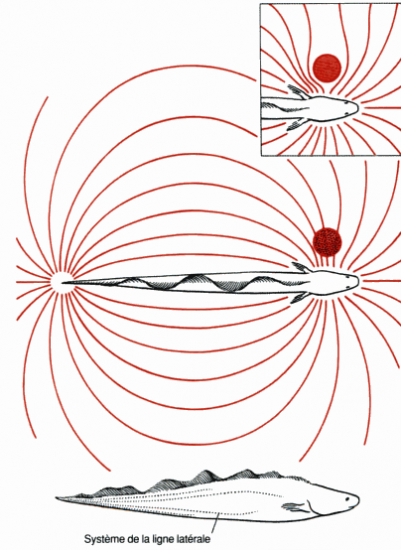
Electroreceptie bij vissen
How Do Sharks and Rays Use Electricity to Find Hidden Prey?
- Magnetite in Human Tissues: A Mechanism for the Biological Effects of Weak ELF Magnetic Fields
Bioelectromagnetics Supplement 1 :101-113 (1992)
Joseph L. Kirschvink, Atsuko Kobayashi-Kirschvink, Juan C. Diaz-Ricci, and Steven J. Kirschvink
- Toelichting van de Amerikaanse medisch-wetenschappelijk journalist Blake Levitt:
"I have a section on magnetite in my first book, Electromagnetic Fields and discuss Kirchvink's work. Magnetite is found in every living thing so far investigated and is thought to surround the human meninges of the brain. It is thought to be responsible for bird migratory abilities (eye and beak areas are loaded) and the "honey bee dance" for which Karl Von Frisch won the Nobel Prize in the 1970's. Bee abdomens are loaded with it -- the likely coupling mechanism for external EMFs and whole colony collapse, if EMFs are found to play a role. Even soil bacteria -- magnetobacteria -- are almost 100% magnetite. Magnetite is 300 million times more sensitive to external magnetic fields than any other known material. And we all manufacture it. It is probably the mechanism by which cows have been found to face north along the earth's axis."
Kirschvink et al. found significant levels of magnetite in all areas of the brain with highest levels in the meninges. There were about 5 million crystals per gram of tissue with over 100 million in the meninges. Two types of magnetite were found and it mostly occurred in clumps, organized in magnetosomes - the long crystal chains found in magnetic bacteria and fish as well as other species, which use the earth's magnetic fields for directional information. They found ferromagnetite, which reacts a million times more strongly. Anyone who has my first book, there's a section called Magnetic Materials in Body Tissue, pp. 151-152, and lots of other citations throughout. Kirschvink also has a chapter in one of Martin Blank's books.
A British research named Robin Baker also found magnetite in the human ethmoid bone in the sinus region where many think our "magnetic compass" is located. Baker was able to disturb test subject's sense of direction for up to two hours by applying a bar magnet to the forehead for only 15 minutes. The body also has other magnetic materials - iron & copper. But magnetite is by far the most interesting."
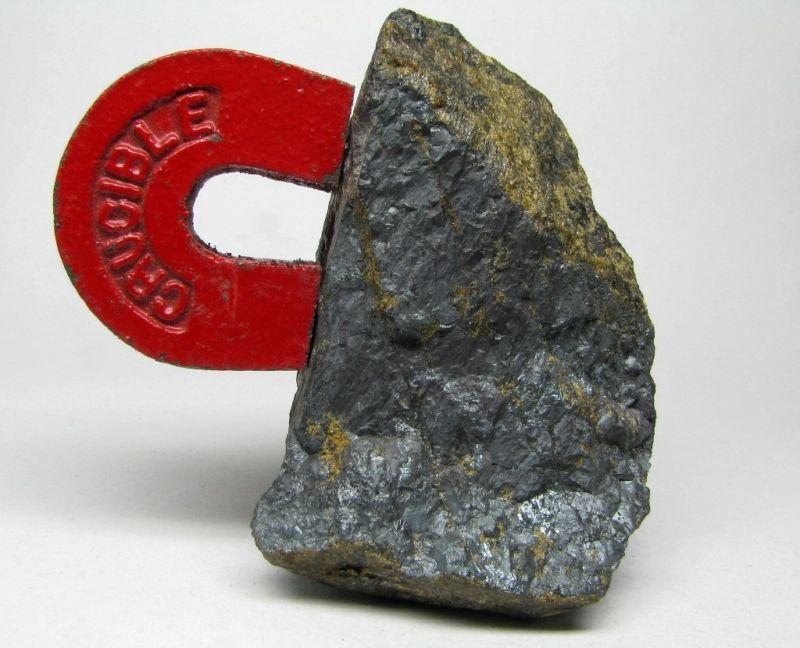
Magnetiet: een mineraal met sterke magnetische eigenschappen
- Magnetite biomineralization in the human brain, Biophysics Vol. 89, pp. 7683-7687, August 1992
Joseph l. Kirschvink, Atsuko Kobayashi-kirschvink, and Barbara J. Woodford
Division of Geological and Planetary Sciences, The California Institute of Technology
Abstract:
Although the mineral magnetite (Fe3O4) is precipitated biochemically by bacteria, protists, and a variety of animals, it has not been documented previously in human tissue. Using an ultrasensitive superconducting magnetometer in a clean-lab environment, we have detected the presence of ferromagnetic material in a variety of tissues from the human brain. Magnetic particle extracts from solubilized brain tissues examined with high-resolution transmission electron microscopy, electron diffraction, and elemental analyses identify minerals in the magnetitemaghemite family, with many of the crystal morphologies and structures resembling strongly those precipitated by magnetotactic bacteria and fish.
These magnetic and high-resolution transmission electron microscopy measurements imply the presence of a minimum of 5 million single-domain crystals per gram for most tissues in the brain and >100 million crystals per gram for pia and dura. Magnetic property data indicate the crystals are in clumps of between 50 and 100 particles. Biogenic magnetite in the human brain may account for high-field saturation effects observed in the Ti and T2 values of magnetic resonance imaging and, perhaps, for a variety of biological effects of low-frequency magnetic fields.
- Human cryptochrome exhibits light-dependent magnetosensitivity (2011)
Studie gepubliceerd in Nature Communications
"Humans are not believed to have a magnetic sense, even though many animals use the Earth's magnetic field for orientation and navigation. One model of magnetosensing in animals proposes that geomagnetic fields are perceived by light-sensitive chemical reactions involving the flavoprotein cryptochrome (CRY). Here we show using a transgenic approach that human CRY2, which is heavily expressed in the retina, can function as a magnetosensor in the magnetoreception system of Drosophila and that it does so in a light-dependent manner. The results show that human CRY2 has the molecular capability to function as a light-sensitive magnetosensor and reopen an area of sensory biology that is ready for further exploration in humans."
"(Our results) suggest that a reassessment of human magnetosensivitiy may be in order"
Gerelateerde artikels:
- Humans have a magnetic sensor in our eyes, but can we detect magnetic fields? (Discover Magazine, juni 2011)
- The Eyes Have It: A Protein for Magnetic Sensing (Scientific American, juni 2011)
- Magnetoception (Wikipedia)
- Studie: Magnetic characterization of isolated candidate vertebrate magnetoreceptor cells
Published in the Proceedings of the National Academy of Sciences (PNAS), June 8, 2012
Abstract
Over the past 50 years, behavioral experiments have produced a large body of evidence for the existence of a magnetic sense in a wide range of animals. However, the underlying sensory physiology remains poorly understood due to the elusiveness of the magnetosensory structures. Here we present an effective method for isolating and characterizing potential magnetite-based magnetoreceptor cells. (...) This would also explain interference of ac power-line magnetic fields with magnetoreception, as reported in cattle.
- Ook ratten en konijnen blijken over een magnetosensorisch vermogen te beschikken:
Magnetosensory function in rats: localization using positron emission tomography
"Exposure to the magnetic field stimulated cerebellar uptake of fluorodeoxyglucose compared to the sham exposure in the same animals. The activated region was located in the posterior central cerebellum. The results indicated that magnetosensory evoked potentials in rats were associated with increased glucose utilization in the cerebellum, thereby supporting earlier evidence that electromagnetic field transduction occurred in the brain."
Consistent magnetic-field induced dynamical changes in rabbit brain activity (PubMed)
"The reports dealing with the effects of electromagnetic fields (EMFs) on brain electrical activity have been inconsistent. We suspected that the use of linear methods and models accounted for some of the variability, and we explored the issue by using a novel approach to study the effects of EMFs on the electroencephalogram (EEG) from rabbits. (...) We conclude that EMF transduction resulting in changes in brain electrical activity could be demonstrated consistently using a nonlinear method of analysis."
- Evidence of a nonlinear human magnetic sense (studie gepubliceerd in Neuroscience, zie PubMed)
"The occurrence of MEPs in response to a weak magnetic field suggested the existence of a human magnetic sense. In distinction to the evoked potentials ordinarily studied, MEPs were nonlinearly related to the stimulus as evidenced by the need to employ a nonlinear method to detect the responses."
- Studie: Why are living things sensitive to weak magnetic fields?. Electromagnetic Biology and Medicine (2013). Abraham R. Liboff
Abstract
"There is evidence for robust interactions of weak ELF magnetic fields with biological systems. Quite apart from the difficulties attending a proper physical basis for such interactions, an equally daunting question asks why these should even occur, given the apparent lack of comparable signals in the long-term electromagnetic environment. We suggest that the biological basis is likely to be found in the weak (50 nT) daily swing in the geomagnetic field that results from the solar tidal force on free electrons in the upper atmosphere, a remarkably constant effect exactly in phase with the solar diurnal change. Because this magnetic change is locked into the solar-derived everyday diurnal response in living things, one can argue that it acts as a surrogate for the solar variation, and therefore plays a role in chronobiological processes. This implies that weak magnetic field interactions may have a chronodisruptive basis, homologous to the more familiar effects on the biological clock arising from sleep deprivation, phase-shift employment and light at night. It is conceivable that the widespread sensitivity of biological systems to weak ELF magnetic fields is vestigially derived from this diurnal geomagnetic effect."
- Onderzoek van Fredrik Stormer en collega's, Norwegian Institute of Public Health:
- Studie: Membrane-bound memory in the neurons? Medical Hypotheses 73, 462 (2009)
- Studie: Are the astrocytes involved in magnetite-based memory? Medical Hypotheses (2009)
- Studie: Evolution and possible storage of information in a magnetite system of significance for brain development, Medical Hypotheses, 2011
- Studie: Long-term memory in brain magnetite. Medical Hypotheses (2009)
Marcos Arturo Martínez Banaclocha, István Bókkon, Helios Martínez Banaclocha.
Abstract:
Despite theoretical and experimental efforts to model neuronal networks, the origin of cerebral cognitive functions and memory formation are still unknown. Recently, we have proposed that in addition to chemical and electrical signals, the cellular components of the neocortex (especially neurons and astrocytes) may communicate with each other through magnetic signals generated by themselves. This magnetic communication would be the ground of short-term memory. In the present paper, we propose that brain magnetite may be a component of the mechanisms, conserved during evolution, to detect and transduce magnetic fields generated inside the cerebral neocortex. Specifically, we propose a possible role for magnetite nanoparticles, distributed through neuronal and astroglial membranes, in perception, transduction and storage of information that arrives to the neocortex.
Excerpt:
"Traditionally, electromagnetic fields (EMFs) bioeffects have been explained as a consequence of biophysical interactions between EMFs and membranes, leading to changes in cell behavior. Recently, it has been proposed a neural transduction hypothesis for explain EMFs effects in cells.
This hypothesis suggests that EMFs exposure will result in the modulation of the membrane conductance of ion channels, through interactions with extracellular or membrane-bound proteins. We propose that biomagnetite may have a key role in the transduction of the magnetic signals produced inside the neocortex itself. In virtue of their physico-chemical properties, it is plausible that magnetite crystals were synthesized and distributed in the human brain in a specific and controlled form. Having in account that neurons and astrocytes generate the strongest magnetic fields into the brain and that magnetite seems to be homogeneously distributed in neuronal and astroglial membranes, we suggest that:
(a) NAAMFs may drive the distribution and organization of biomagnetite nanoparticles (single domain and/or superparamagnetic) in neuronal membranes, which would result in a nonrandom distribution of these crystals in neuronal surfaces;
(b) if alternating magnetic fields associated with each neuron activity drive magnetite distribution on their own membranes, this would mean that each neurons might have a specific biomagnetite hallmark, depending on their activity and connectivity; these magnetite signatures would change depending on long-time activity of each specific neuronal circuit and would constitute a dynamic process;
(c) this non-random but specific distribution of magnetite on neuronal surfaces might have an important role in the induction of static 3-D magnetic constructs in neocortical astrocytes
(d) this organization of static (dc) astroglial magnetic fields generated around neuronal minicolumns would influence magnetite nanoparticles distribution in astroglial membranes;
(e) this biomagnetite distribution in neocortical astroglial network would store long-term information
- Studie: Discovery of magnetite in the exhausted material from a diesel engine
Abstract:
Magnetite was detected in the particulate matter collected from diesel engine exhaust using a total exhaust dilution tunnel. This discovery is very important in determining the health effects of exposure to magnetite or its interaction with static magnetic fields or low-frequency electromagnetic fields. Magnetite is the best absorber of microwave radiation of any biological material in the 0.5–10 GHz frequency range through the process of electromagnetic resonance. This includes the frequencies that are normally used in the cellular telephone industry.
- Studie in Nature: elektromagnetische velden verstoren oriëntatievermogen vogels
PubMed - "The disruptive effect of radiofrequency electromagnetic fields is not confined to a narrow frequency band and birds tested far from sources of electromagnetic noise required no screening to orient with their magnetic compass. These fully double-blinded tests document a reproducible effect of anthropogenic electromagnetic noise on the behaviour of an intact vertebrate."



